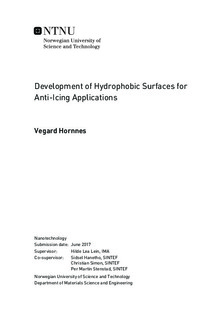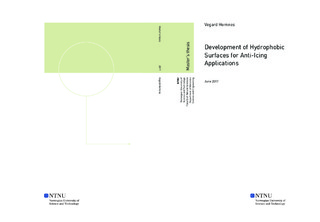| dc.description.abstract | Ice accumulation on outdoor infrastructure is a major problem for many industries. Several strategies are commonly employed to remove ice, but they are often expensive or have negative environmental consequences. An alternative strategy is to utilize anti-icing surfaces, which can prevent ice formation or make it easier to remove. A surface that has been investigated for its anti-icing properties are hydrophobic surfaces. These surfaces are extremely water-repellent, and they have also been shown to suppress icing and lower ice adhesion.
In this work, hydrophobic surfaces have been created on aluminium by combining a hierarchical roughness on the micro- and nanoscale with a low surface energy coating. Aluminium has been sandblasted with coarse and fine sand, resulting in two different microstructures. Silicon dioxide nanoparticles were synthesised and deposited through spray coating in different amounts, and were found to be 186 plus/minus 12 nm in diameter. A low surface energy sol-gel coating based on the fluorosilane precursor 1H,1H,2H,2H-Perfluorooctyltriethoxysilane was synthesised and deposited in one or several layers via spray coating. The micro- and nanostructure that resulted from the experimental parameters were optimized. The most hydrophobic substrate was coarsely sandblasted, had silicon dioxide nanoparticles and a single layer of fluorosilane coating. It demonstrated a contact angle of 165.7 plus/minus 1.3 degrees, and a contact angle hysteresis of 22.8 plus/minus 1.6 degrees.
The anti-icing properties of the hydrophobic surfaces have been investigated by measuring the temperature that water froze on the surfaces, the delay before water froze at -10 degrees Celsius and the effect of several icing/deicing cycles. The coating lowered the freezing significantly, but it was not affected by the microstructure. The lowest freezing temperature was -13.1 plus/minus 1.1 degrees Celsius on a substrate with reduced nanoparticle deposition. The most hydrophobic substrate registered the longest freezing delay at 43 minutes. But other, less hydrophobic substrates also showed long freezing delays. Thus, no correlation between hydrophobicity and anti-icing properties was found. In addition, the humidity was found to have a major influence on the hydrophobicity and anti-icing properties, because of condensation and frost formation. | |

